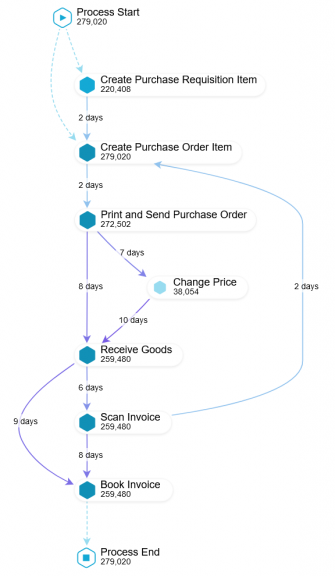Process Mining
Discovering, analyzing and optimizing processes
Do you know how much potential is hidden in your company’s data? Most companies rely extensively on IT systems to support their business processes. This creates huge amounts of data that can contain valuable information on the way your processes work. Analytical process mining can help you gain insight into large amounts of data and derive relevant process knowledge in a targeted manner.
How does process mining work?
Process mining uses the event logs generated by your IT systems. Mathematical algorithms are used to uncover correlations between the data sets and visualize them. As a user, you will receive the resulting process diagrams, enabling you to take an in-depth look at your processes. Various controls and KPIs provide guidance and can help you discover deviations in your processes.

Process mining tailored to your needs
You can adapt process mining at any time to suit your individual needs. Depending on the aspects you wish to analyze, you can employ various analytical models or a combination thereof. For example, the following methods are available:
Discovery
Process mining algorithms automatically generate an as-is process model, including all deviating process variants. Standard and freely definable KPIs offer valuable information for evaluating your business processes. These indicators include lead time, processing and waiting time, the degree of automation, the average number of process steps, multiple submissions and forwarding or fulfillment rates.
Conformance check
This analytical approach compares a defined target process with an actual process instance. The conformance check can determine whether reality and the model match. It highlights any deviations between the models and shows the underlying reasons. Example: A guideline specifies that orders valued at more than €100,000 require approval. With process mining, you can find out directly whether this rule is being complied with and what the potential causes of errors are.
Proactive approach
This approach is geared towards translating process insights into concrete activities. Depending on the strategy, state-of-the-art algorithms can suggest possible actions or initiate appropriate measures. Example: Unnecessary additional costs are incurred if invoices are not paid in due time. In this case, it may be sensible to automatically settle specific invoices, while escalating others.
Your benefits with process mining
The increasing competitive pressure requires companies to continuously adapt their organizational set-up – and knowledge about the process landscape is indispensable here. Process mining helps you gain the insight you need, while simultaneously providing a solution to two important issues:
-
Incomplete processes
The overview is centered on (process) data and delivers an unbiased and comprehensive picture – including all deviations. -
Timeliness
IT systems continuously generate new data and indirectly ensure that the process view remains up to date. This reduces the need for manually maintained process maps, which can be eliminated from the process step by step.
Any Questions?
If you would like to know more about this subject, I am happy to assist you.
ZUM KONTAKTFORMULAR
